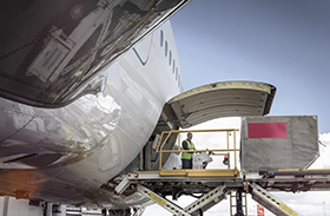
Translations
La demanda de carga aérea se suaviza en noviembre (pdf)
Ralentissement du trafic de fret aérien en novembre (pdf)
Demanda por carga aérea diminui em novembro (pdf)
国际航协:11月航空货运需求疲软 (pdf)
Geneva - The International Air Transport Association (IATA) released data for November 2022 global air cargo markets showing that demand softened as economic headwinds persist.
Global demand, measured in cargo tonne-kilometers (CTKs*), fell 13.7% compared to November 2021 (-14.2% for international operations).
Capacity (measured in available cargo tonne-kilometers, ACTK) was 1.9% below November 2021. This was the second year-on-year contraction following the first last month (in October) since April 2022. International cargo capacity decreased 0.1% compared to November 2021.
Compared to pre-COVID-19 levels (November 2019), there was a smaller contraction in overall demand (-10.1%), while capacity was down 8.8%.
Several factors in the operating environment should be noted:
- Global new export orders, a leading indicator of cargo demand, were stable in October. For major economies, new export orders are shrinking except in Germany, the US, and South Korea, where they grew.
- Global goods trade expanded by 3.3% in October. Given the softening in air cargo demand, this suggests that maritime cargo was the primary beneficiary.
- The US dollar has appreciated sharply, adding cost pressure as many costs are denominated in US dollars. This includes jet fuel, which is already at elevated levels.
- The Consumer Price Index for G7 countries decreased from 7.8% in October to 7.4% in November, the largest month-on-month decline in 2022. Inflation in producer (input) prices reduced to 12.7% in November, its lowest level so far in 2022.
“Air cargo performance softened in November, the traditional peak season. Resilience in the face of economic uncertainties is demonstrated with demand being relatively stable on a month-to-month basis. But market signals are mixed. November presented several indicators with upside potential: oil prices stabilized, inflation slowed and there was a slight expansion in goods traded globally. But shrinking export orders globally and China’s rising COVID cases are cause for careful monitoring,” said Willie Walsh, IATA’s Director General.
| Air Cargo Market in detail - November 2022 | World share1 | CTK | ACTK | CLF(%-PT)2 | CLF(Level)3 |
|---|---|---|---|---|---|
|
Total Market |
100.0% |
-13.7% |
-1.9% |
-6.7% |
49.1% |
|
Africa |
1.9% |
-6.3% |
-11.4% |
2.5% |
45.8% |
|
Asia Pacific |
32.6% |
-18.6% |
-4.5% |
-9.5% |
54.5% |
|
Europe |
22.8% |
-16.5% |
-6.6% |
-6.8% |
56.9% |
|
Latin America |
2.2% |
2.8% |
19.9% |
-6.4% |
38.2% |
|
Middle East |
13.4% |
-14.7% |
2.1% |
-9.3% |
47.5% |
|
North America |
27.2% |
-6.6% |
0.3% |
-3.1% |
41.9% |
1) % of industry CTKs in 2021 2) Year-on-year change in load factor 3) Load Factor Level
November Regional Performance
Asia-Pacific airlines saw their air cargo volumes decrease by 18.6% in November 2022 compared to the same month in 2021. This was the worst performance of all regions and a decline in performance compared to October (-14.7%). Airlines in the region continue to be impacted by lower levels of trade and manufacturing activity and disruptions in supply chains due to China’s rising COVID cases. Available capacity in the region decreased by 4.5% compared to 2021.
North American carriers posted a 6.6% decrease in cargo volumes in November 2022 compared to the same month in 2021. This was an improvement in performance compared to October (-8.6%). Capacity increased 0.3% compared to November 2021.
European carriers saw a 16.5% decrease in cargo volumes in November 2022 compared to the same month in 2021. This was an improvement in performance compared to October (-18.8%), thanks to the stronger new export orders in Germany. Airlines in the region continue to be most affected by the war in Ukraine. High inflation levels, most notably in Türkiye, also affected volumes. Capacity decreased 6.6% in November 2022 compared to November 2021.
Middle Eastern carriers experienced a 14.7% year-on-year decrease in cargo volumes in November 2022. This was a marginal improvement to the previous month (-15.0%). Cargo volumes to/from Europe impacted the region’s performance, registering a 16.3% year-on-year decline in November. Capacity increased 2.1% compared to November 2021.
Latin American carriers reported a 2.8% increase in cargo volumes in November 2022 compared to November 2021. This was the strongest performance of all regions, and a significant improvement in performance compared to October (-1.4%). Capacity in November was up 2.8% compared to the same month in 2021.
African airlines saw cargo volumes decrease by 6.3% in November 2022 compared to November 2021. This was an improvement in performance compared to the previous month (-8.3%). Capacity was 11.4% below November 2021 levels.
> View November Air Cargo Market Analysis (pdf)
For more information, please contact:
Corporate Communications
Tel: +41 22 770 2967
Email: corpcomms@iata.org
Notes for Editors:
- * Please note that as of January 2020 onwards, we have clarified the terminology of the Industry and Regional series from ‘Freight’ to ‘Cargo’, the corresponding metrics being FTK (changed to ‘CTK’), AFTK (changed to ‘ACTK’), and FLF (changed to ‘CLF’), in order to reflect that the series have been consisting of Cargo (Freight plus Mail) rather than Freight only. The data series themselves have not been changed.
- IATA (International Air Transport Association) represents some 300 airlines comprising 83% of global air traffic.
- You can follow us at twitter.com/iata for announcements, policy positions, and other useful industry information.
- Explanation of measurement terms:
- CTK: cargo tonne-kilometers measures actual cargo traffic
- ACTK: available cargo tonne-kilometers measures available total cargo capacity
- CLF: cargo load factor is % of ACTKs used
- IATA statistics cover international and domestic scheduled air cargo for IATA member and non-member airlines.
- Total cargo traffic market share by region of carriers in terms of CTK is: Asia-Pacific 32.6%, Europe 22.8%, North America 27.2%, Middle East 13.4%, Latin America 2.2%, and Africa 1.9%.

